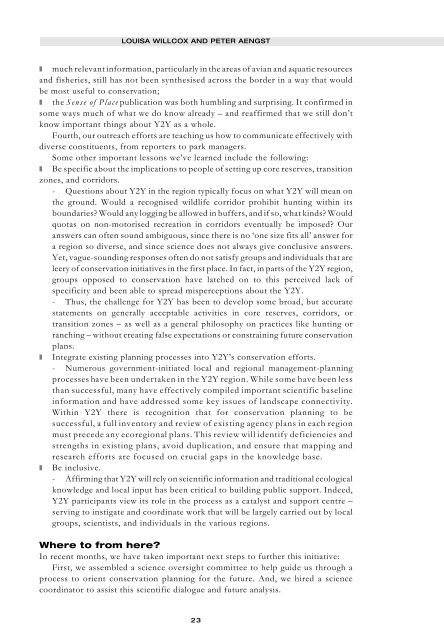Parks - IUCN
Parks - IUCN
Parks - IUCN
You also want an ePaper? Increase the reach of your titles
YUMPU automatically turns print PDFs into web optimized ePapers that Google loves.
LOUISA WILLCOX AND PETER AENGST<br />
❚ much relevant information, particularly in the areas of avian and aquatic resources<br />
and fisheries, still has not been synthesised across the border in a way that would<br />
be most useful to conservation;<br />
❚ the Sense of Place publication was both humbling and surprising. It confirmed in<br />
some ways much of what we do know already – and reaffirmed that we still don’t<br />
know important things about Y2Y as a whole.<br />
Fourth, our outreach efforts are teaching us how to communicate effectively with<br />
diverse constituents, from reporters to park managers.<br />
Some other important lessons we’ve learned include the following:<br />
❚ Be specific about the implications to people of setting up core reserves, transition<br />
zones, and corridors.<br />
- Questions about Y2Y in the region typically focus on what Y2Y will mean on<br />
the ground. Would a recognised wildlife corridor prohibit hunting within its<br />
boundaries? Would any logging be allowed in buffers, and if so, what kinds? Would<br />
quotas on non-motorised recreation in corridors eventually be imposed? Our<br />
answers can often sound ambiguous, since there is no ‘one size fits all’ answer for<br />
a region so diverse, and since science does not always give conclusive answers.<br />
Yet, vague-sounding responses often do not satisfy groups and individuals that are<br />
leery of conservation initiatives in the first place. In fact, in parts of the Y2Y region,<br />
groups opposed to conservation have latched on to this perceived lack of<br />
specificity and been able to spread misperceptions about the Y2Y.<br />
- Thus, the challenge for Y2Y has been to develop some broad, but accurate<br />
statements on generally acceptable activities in core reserves, corridors, or<br />
transition zones – as well as a general philosophy on practices like hunting or<br />
ranching – without creating false expectations or constraining future conservation<br />
plans.<br />
❚ Integrate existing planning processes into Y2Y’s conservation efforts.<br />
- Numerous government-initiated local and regional management-planning<br />
processes have been undertaken in the Y2Y region. While some have been less<br />
than successful, many have effectively compiled important scientific baseline<br />
information and have addressed some key issues of landscape connectivity.<br />
Within Y2Y there is recognition that for conservation planning to be<br />
successful, a full inventory and review of existing agency plans in each region<br />
must precede any ecoregional plans. This review will identify deficiencies and<br />
strengths in existing plans, avoid duplication, and ensure that mapping and<br />
research efforts are focused on crucial gaps in the knowledge base.<br />
❚ Be inclusive.<br />
- Affirming that Y2Y will rely on scientific information and traditional ecological<br />
knowledge and local input has been critical to building public support. Indeed,<br />
Y2Y participants view its role in the process as a catalyst and support centre –<br />
serving to instigate and coordinate work that will be largely carried out by local<br />
groups, scientists, and individuals in the various regions.<br />
Where to from here?<br />
In recent months, we have taken important next steps to further this initiative:<br />
First, we assembled a science oversight committee to help guide us through a<br />
process to orient conservation planning for the future. And, we hired a science<br />
coordinator to assist this scientific dialogue and future analysis.<br />
23

















